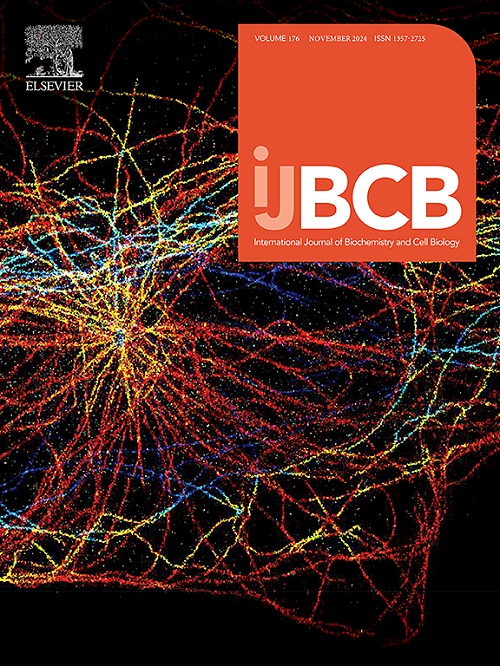CDON的N-糖基化改变会促进H9c2心肌细胞中由H2O2诱导的DNA损伤。
IF 3.4
3区 生物学
Q2 BIOCHEMISTRY & MOLECULAR BIOLOGY
International Journal of Biochemistry & Cell Biology
Pub Date : 2024-10-09
DOI:10.1016/j.biocel.2024.106671
引用次数: 0
摘要
蛋白质糖基化与 DNA 损伤有关。最近,DNA 损伤与心力衰竭的发病机制有关。细胞粘附相关癌基因调控(CDON)被认为是一种N-连接糖蛋白,是一种调节心脏功能的跨膜受体。但 CDON 及其糖基化在 DNA 损伤中的作用仍然未知。在本研究中,我们发现敲除 CDON 会导致 DNA 双链断裂,表现为磷酸化组蛋白 H2AX(γH2AX)蛋白水平、γH2AX 免疫荧光强度和 H9c2 心肌细胞尾部 DNA 矩的增加。相反,CDON的过表达会降低过氧化氢(H2O2)诱导的DNA损伤,并上调DNA修复途径--同源重组(HR)和非同源末端连接(NHEJ)相关基因的表达。此外,我们还在H9c2细胞中表达了9个预测的N-糖基化位点突变体,然后再用H2O2处理。结果表明,N-糖基化位点(N99Q、N179Q和N870Q)的突变增加了DNA损伤的积累,并下调了HR相关基因的表达,这表明CDON在DNA损伤上的N-糖基化是位点特异性的,这些特定的N-糖基化位点可能调控HR修复相关基因的转录本丰度。我们的数据强调了CDON的N-糖基化对心肌细胞DNA损伤至关重要。这可能揭示了针对心脏病DNA损伤途径的潜在策略。本文章由计算机程序翻译,如有差异,请以英文原文为准。
Alteration of N-glycosylation of CDON promotes H2O2-induced DNA damage in H9c2 cardiomyocytes
Protein glycosylation is involved in DNA damage. Recently, DNA damage has been connected with the pathogenesis of heart failure. Cell adhesion associated, oncogene regulated (CDON), considered as an N-linked glycoprotein, is a transmembrane receptor for modulating cardiac function. But the role of CDON and its glycosylation in DNA damage remains unknown. In this study, we found that the knockdown of CDON caused DNA double-strand breaks as indicated by an increase in phosphorylated histone H2AX (γH2AX) protein level, immunofluorescent intensity of γH2AX and tail DNA moment in H9c2 cardiomyocytes. Conversely, overexpression of CDON led to decreasing DNA damage induced by hydrogen peroxide (H2O2) and upregulating the expression of genes related to DNA repair pathways-homologous recombination (HR) and non-homologous end joining (NHEJ). Moreover, we expressed nine predicted N-glycosylation site mutants in H9c2 cells prior to treatment with H2O2. The results showed that mutation of N-glycosylation sites (N99Q, N179Q, and N870Q) increased the accumulation of DNA damage and downregulated the expression of HR-related genes, demonstrating that CDON N-glycosylation on DNA damage is site-specific and these specific N-glycan sites may regulate HR repair-related transcript abundance of genes. Our data highlight that N-glycosylation of CDON is critical to cardiomyocyte DNA lesion. It may uncover the potential strategies targeting DNA damage pathway in heart disease.
求助全文
通过发布文献求助,成功后即可免费获取论文全文。
去求助
来源期刊
CiteScore
8.10
自引率
0.00%
发文量
124
审稿时长
19 days
期刊介绍:
IJBCB publishes original research articles, invited reviews and in-focus articles in all areas of cell and molecular biology and biomedical research.
Topics of interest include, but are not limited to:
-Mechanistic studies of cells, cell organelles, sub-cellular molecular pathways and metabolism
-Novel insights into disease pathogenesis
-Nanotechnology with implication to biological and medical processes
-Genomics and bioinformatics

 求助内容:
求助内容: 应助结果提醒方式:
应助结果提醒方式:


